Tips for bringing home a new puppy with another dog – There is nothing quite as thrilling as getting a new puppy, especially for an owner with another furry ‘child.’ That is another thing since the other ‘child’ has remained the cherished canine in the home for some time.
However, its share of the limelight is being taken by the ‘no one can dethrone me’ boy— the new puppy! Dogs are as charming as they are, and it is almost a rite of passage for people to let out an ‘aw!’ when they come across someone with a puppy.
Although the anticipation for a new canine addition is high in situations like this one, it usually takes time. New dogs will eventually find themselves at home as much as the current mouse, but nothing longer than a week.
Such hopes are usually short-lived since a new dog will have potential when it gets to the door. Their results can be collected without frustration with some secret strategies and the necessary patience. Going to the door in the morning is no longer a dreary task.
We will present some guidelines on acquiring a new puppy, assuming there is already a dog in the residence. We will touch on the very beginning of the process and how to make these few opening weeks bearable for both pets.
Tips for Bringing Home a New Puppy With Another Dog
here are some tips for bringing home a new puppy with another dog:
1. Preparing Your Home
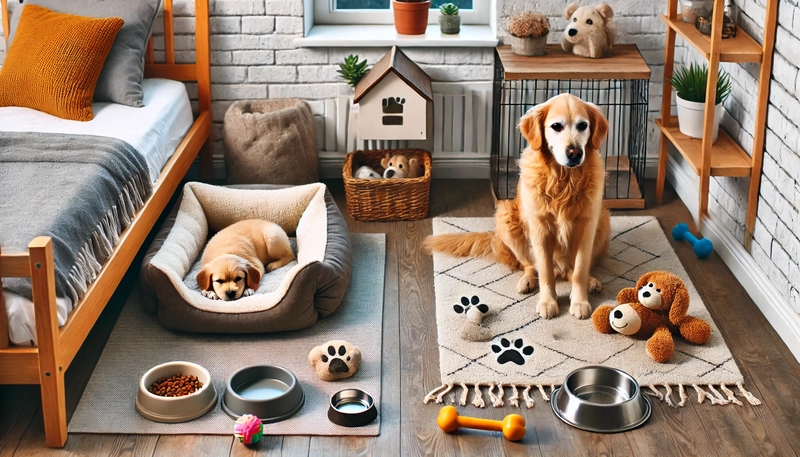
Getting used to the fact that a dog will be coming to your place is already demanding enough. Preparation also helps decrease unease and offers a less acrid stance.
Set Up Separate Spaces
First, it is necessary to prepare clearly defined spaces for older and younger animals. In this way, both your dog and the new puppy will have a distinct and safe place to retreat when confronted with the need for privacy.
Puppy’s spot: A specific corner of the premises must be marked where the puppy may retire without disturbance. One can fix a blanket with the bed, food plate, and water bowl.
Dog’s spot: Also, try putting your resident dog in a familiar position, which is much better now because, in such circumstances, people get a little too stiff to allow or accommodate a dog.
Stock Up on Supplies
Gather all the equipment you will need for the new puppy. This should include:
- A puppy crate/basket
- Water and food—separate bowl
- Toys for both dogs to play together
- Puppy food (usually, sth different will be served to the baby)
- Avoiding mixing each dog’s stuff will reduce conflicts arising from territorial aggression.
Check the vet
Book a vet appointment before bringing the puppy in; it is essential. This confirms the new puppy’s health and vaccination details and helps prevent any diseases that could be passed to the existing pet.
2. Introducing the Puppy to Your Dog the Right Way
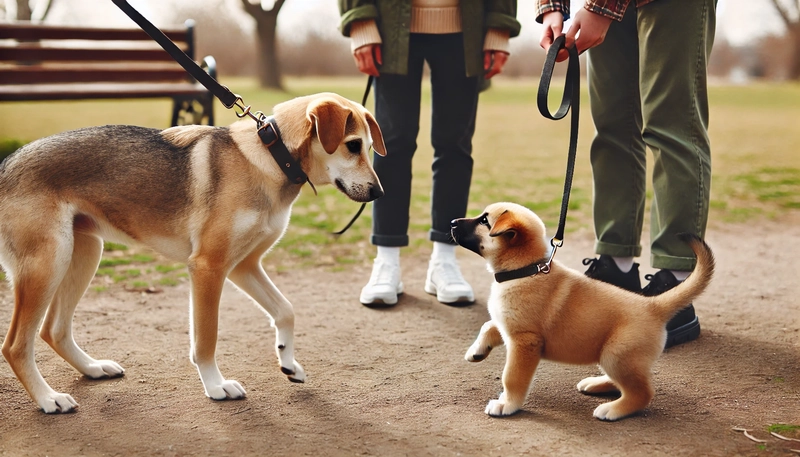
Despite the fact that dogs are man’s eternal friend, they are still animals by nature. As such, they have to acclimate to each other and establish a way to coexist peacefully. This initial stage can be called a Puppy-Dog relationship.
If the procedure is established, such an acquaintance will not be harmful but interesting, exciting, and funny.
Start on Neutral Ground
Since dogs are social beings, fighting the fact that they’re territorial to minimize possible conflicts is impossible.
Therefore, it is better to meet them in neutral territory. Let it be either a park or another dog-lover’s house. The main point is not to make sudden close-up intrusions in each other’s territories.
Keep Both Dogs on a Leash
Therefore, during the first meeting, both dogs should be prevented from attacking each other using collars and leashes. This allows you to manage the situation in case it gets heated. It is possible for the dogs to come closer and to sniff each other.
If both dogs do not react aggressively to each other (the tails are wagging, and the bodies are soft), it is possible for them to get together.
If one of the dogs starts fighting (growling, raising the fur, trying to get closer), you must take the dogs away from each other calmly and resume them after some time.
Take It Slow
Don’t try to introduce the dogs too quickly. Some dogs will need more than a few get-togethers to get to know people better, so you will need to prepare for this.
Many such baby steps ensure that no dogs are scared and do not allow them to freeze in defense mechanisms indefinitely.
3. First Few Days at Home
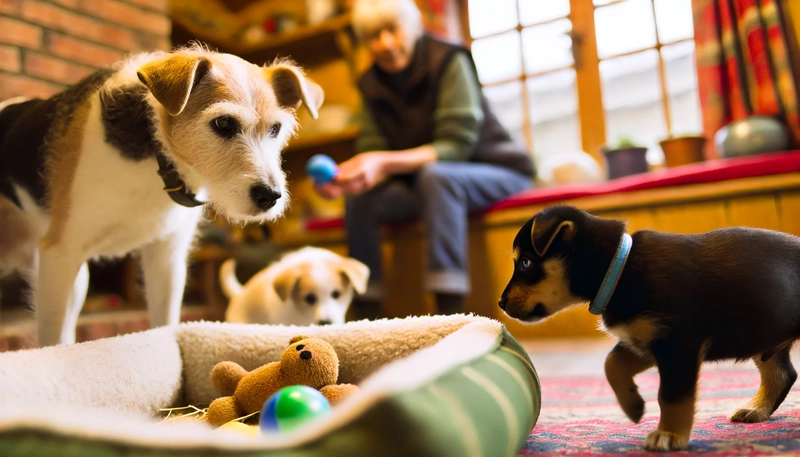
Once the new addition to the family is brought home, attention should be given to the basic house rules for the first few inaugural days to prevent any stresses from developing between the two dogs.
Supervised Interactions
Apart from this, it is essential to supervise the new puppy since it will also help monitor the more in-control animal so that if anything, say, an altercation attempts to develop, it can be stopped.
For this period, one requires all interactions conducted by the puppy and the dog to pay attention to the behavior exhibited.
Watch how they behave with their bodies:
- Signs that are normal when a dog is socializing: wagging tails, play bows, licking the face, etc
- Signs that a dog is uncomfortable: Growling, hiding in corners, and a lot of self-restricting body language.
It’s Best to Feed Both Dogs Separately
It is also very common for dogs to start arguing over food. To avoid such disputes, these dogs should be fed in different places: one bowl for one puppy and one for another. This will enable the dogs to eat comfortably and ensure that one does not worry about the other.
Give Both Dogs Equal Attention
Sometimes, people lose themselves too much in getting a new pet to ignore the feelings of the old pet. Do not focus only on the puppy at the expense of the older dog.
Have a schedule that will ensure that each dog has time to enjoy time with you, be it playing, walking, or petting, so as to avert potential feelings of neglect.
4. Training and Socialization
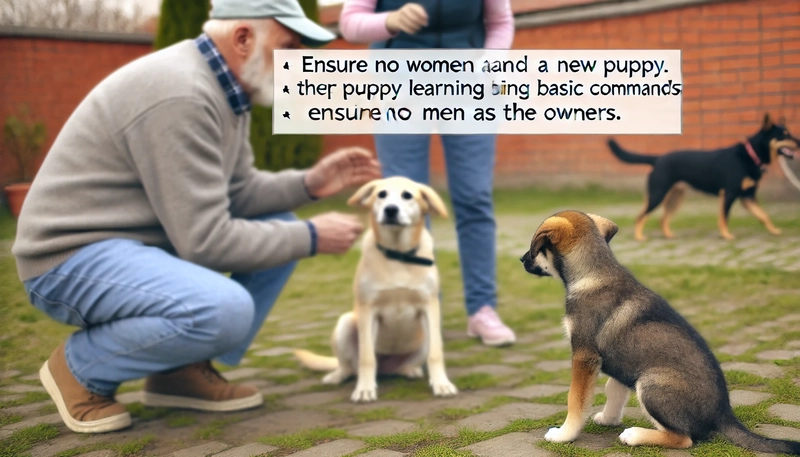
The next step focuses on the interaction between dogs, where education and socializing can be addressed. This is necessary for the dogs to live together in peace.
Teach the Puppy Basic Commands
You have to teach the puppy basic commands “sit,” “stay,” and “come” in no time. It is essential to start behavioral therapy quickly and teach the puppy how to behave in the house.
Encourage Good Behavior in Both Dogs
Give your dogs biscuits or some other treat every time there is play or positive feelings toward one another. This will help them understand that being in each other’s presence is a good thing.
Socialize Both Dogs
A dog that is not socialized is likely to be ill-behaved. Be sure to let both your puppy and your dog interact with new people, places, and other dogs. The more they associate with others, the more likely they are to stand different situations in the future.
5. Building a Strong Bond Between Your Dogs
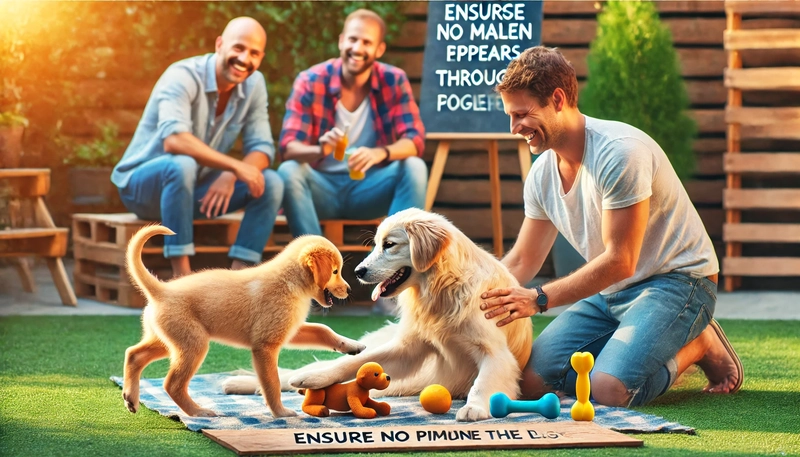
Over some time and effort, your dogs will form a strong understanding with each other. This is how it can be brought about:
Appreciate Playtime
Play is one of the most efficient ways to help dogs to bond. Enriching activities such as ‘fetch’ or ‘tug of war’ should be carried out so that both dogs participate actively. The play should be well monitored to ensure it is not too aggressive.
Take Walks Together
If the dogs take regular walks together, they will learn to appreciate each other better. Walking parallel to each other helps the dogs see each other as members of the same ‘pack.’
Be Patient
Helping dogs establish a strong relationship is daunting as well as fun. Remain flexible and allow them to get to know each other instead of forcing them to become friends from the word go. It only needs to take a long time. It is normal for them to accept each other for a few weeks or even months.
Common Difficulties and How To Solve Them

One challenging part about having another puppy at home is getting your dog to take to it.
1. Jealousy
One problem arising from the presence of the new pet is that your old pet may feel jealous because the new pet is receiving all the love and care. To ensure the current dog does not have this jealousy, walk or play with only one dog at a time. Also, ensure that your dog is content and does not feel neglected.
2. Resource Guarding
One dog might not like sharing its food or a particular toy with another dog. If this behavior is noticed, the two should not be allowed to simultaneously have their favorite toys or bones near them. This helps so that the dogs do not start fighting.
3. Over-Excitement
Very often, the new puppy has a lot of energy, which could also cause problems for the fragile senior dog. If your male puppy is bothered by your dog, keep them separate for most of the day. And relax both dogs.
| Behavior | Meaning |
| Wagging tail | Your dog is happy and excited |
| Play bow | Your dog wants to play with the new puppy |
| Growling | Your dog feels uncomfortable or threatened |
| Stiff posture | Your dog is unsure or tense |
| Gentle nipping | This is a sign of playful behavior (as long as it’s gentle) |
| Hiding | Your dog may be overwhelmed and needs some alone time |
Final Tips for a Successful Transition
Finally, with the introduction of the new members’ friends, here are some concluding dos and don’ts that will help in ensuring the change is successful:
- Remain calm, and your dogs will feel your stress. Remain quiet and composed throughout bringing in the two dogs.
- Staying on course is crucial – The activities should follow a fixed schedule that all family members and dogs will be comfortable with to keep stress levels low.
- Space allowed—If the affected dog does not feel up to par, it should be free to take care of itself in its own way.
These are excellent ways to give each dog a good foundation for a happy and lasting bond, but as always, it should be noted that every dog is unique. Some may bond instantly, whereas others may require some time, but the one thing for sure is that your affection and concern will assist them through the new phase.